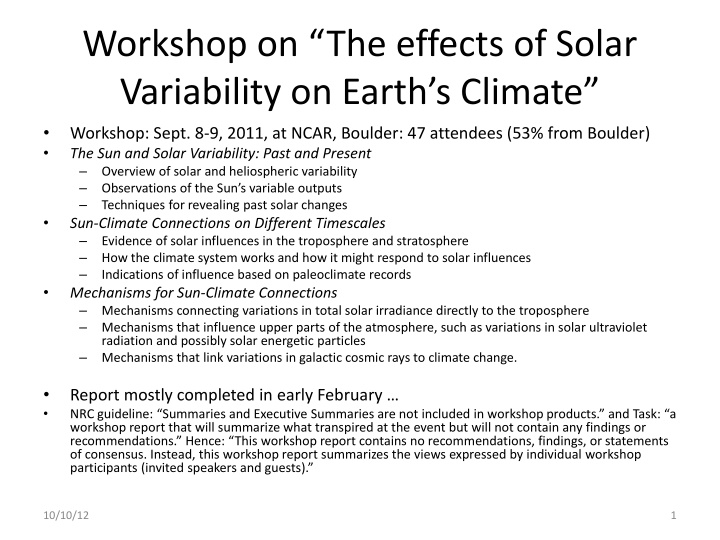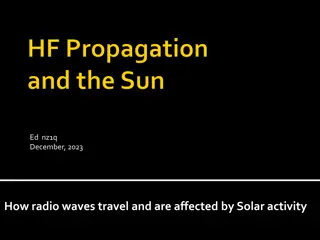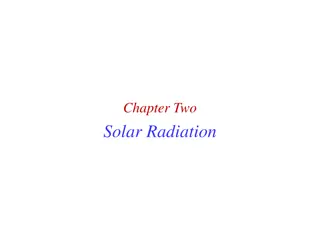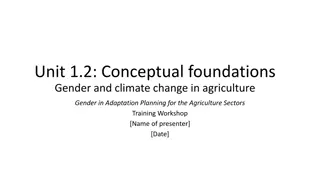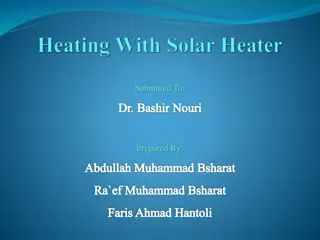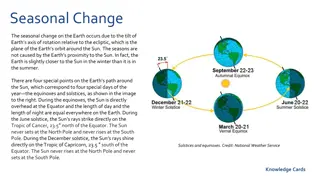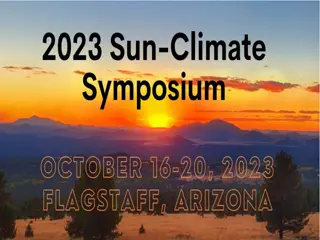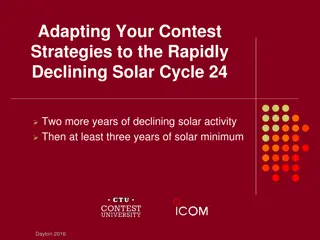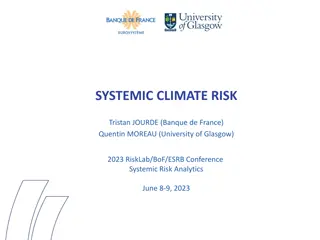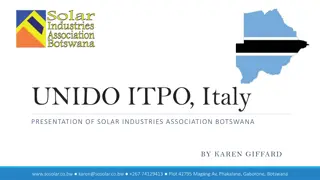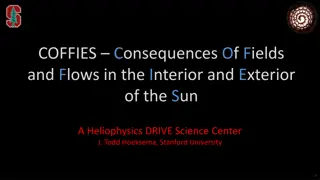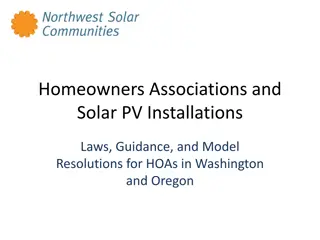Workshop on Solar Variability Effects on Earth's Climate
This workshop, held in Boulder in 2011, explored solar variability and its impact on Earth's climate. Topics included solar influences on the troposphere and stratosphere, mechanisms connecting solar changes to climate, and evidence from paleoclimate records. The event featured sessions on radiometry for solar observations, solar-terrestrial influences on climate change, and cosmic ray modulation. Experts discussed climate responses to solar variability over different timescales, indirect climate effects of the sun, and solar forcing on the lower atmosphere and oceans.
Uploaded on Mar 12, 2025 | 0 Views
Download Presentation

Please find below an Image/Link to download the presentation.
The content on the website is provided AS IS for your information and personal use only. It may not be sold, licensed, or shared on other websites without obtaining consent from the author.If you encounter any issues during the download, it is possible that the publisher has removed the file from their server.
You are allowed to download the files provided on this website for personal or commercial use, subject to the condition that they are used lawfully. All files are the property of their respective owners.
The content on the website is provided AS IS for your information and personal use only. It may not be sold, licensed, or shared on other websites without obtaining consent from the author.
E N D
Presentation Transcript
Workshop on The effects of Solar Variability on Earth s Climate Workshop: Sept. 8-9, 2011, at NCAR, Boulder: 47 attendees (53% from Boulder) The Sun and Solar Variability: Past and Present Overview of solar and heliospheric variability Observations of the Sun s variable outputs Techniques for revealing past solar changes Sun-Climate Connections on Different Timescales Evidence of solar influences in the troposphere and stratosphere How the climate system works and how it might respond to solar influences Indications of influence based on paleoclimate records Mechanisms for Sun-Climate Connections Mechanisms connecting variations in total solar irradiance directly to the troposphere Mechanisms that influence upper parts of the atmosphere, such as variations in solar ultraviolet radiation and possibly solar energetic particles Mechanisms that link variations in galactic cosmic rays to climate change. Report mostly completed in early February NRC guideline: Summaries and Executive Summaries are not included in workshop products. and Task: a workshop report that will summarize what transpired at the event but will not contain any findings or recommendations. Hence: This workshop report contains no recommendations, findings, or statements of consensus. Instead, this workshop report summarizes the views expressed by individual workshop participants (invited speakers and guests). 10/10/12 1
Workshop agenda Session 1 9:00 Overview and Advances in Radiometry for Solar Observations Greg Kopp, University of Colorado, Boulder 10:00 Assessing Solar and Solar-Terrestrial Influences as a Component of Earth s Climate Change Picture Daniel N. Baker, CU, Boulder 11:00 Heliospheric Phenomena Responsible for Cosmic Ray Modulation at the Earth Joe Giacalone, University of Arizona 11:45 Behavior of Quiet Sun Contributions to Solar Irradiance Peter Foukal, Heliophysics, Inc. (by WebEx), Session Chair 1:15 The Record of Solar Forcing in Cosmogenic Isotope Data Raimund Muscheler, Lund University, Sweden Session 2 2:00 Issues in Climate Science Underlying Sun/Climate Research Isaac M. Held, NOAA GFDL, Session Chair 3:00 Indirect Climate Effects of the Sun Through Modulation of the Mean Circulation Structure Caspar Ammann, NCAR 4:00 Climate Response to the Solar Cycle as Observed in the Stratosphere Lon Hood, University of Arizona 4:45 Direct Solar Forcing of the Lower Atmosphere and Ocean Gerald A. Meehl, National Center for Atmospheric Research Session 3 9:00 Detection of the Solar Signal in Climate from Paleorecords Raymond S. Bradley, University of Massachusetts 9:45 Detecting the Solar Cycle Via Temperature Proxies Back to the Maunder Minimum Gerald North, Texas A&M University 10:45 Climate Response at Earth s Surface to Cyclic and Secular Solar Forcing Ka-Kit Tung, University of Washington, Session Chair 11:40 Solar Effects Transmitted by Stratosphere-Troposphere Coupling Joanna D. Haigh, Imperial College, London Session 4 1:30 The Impact of Energetic Particle Precipitation on the Atmosphere Charles Jackman, NASA Goddard Space Flight Center 2:15 Cosmic Rays and Cloud Nucleation Jeffrey Pierce, Dalhousie University 3:00 Solar Grand Minima Inferred from Observations of Sun-like Stars Dan Lubin, Scripps Institution of Oceanography, UCSD Panel Discussion 3:45 Panel Discussion led by Joanna Haigh and Daniel Baker 1. What is the most recent and/or most compelling evidence of the impact of solar variability on climate, particularly in the lower atmosphere, over decadal timescales? 2. What can we learn of the variability of solar irradiance using paleoclimate records? 3. What can we learn of climate responses to solar variability using paleoclimate records? 4. Are there any significant climate impacts of solar variability on regional scales? 5. What are the research directions, additional observations, and/or model improvements necessary to improve understanding and forecast ability regarding solar variability and climate, particularly over the solar cycle timescale? 10/10/12 2
Research rationale no satellite measurements have indicated that solar output and variability have contributed in a significant way to the increase in global mean temperature in the last 50 years. Locally, however, correlations between solar activity and variations in average weather may stand out beyond the global trend; such has been argued to be the case for the El Ni o-Southern Oscillation, even in the present day. Understanding the significance and magnitude of apparent multi-decade to multi-century Sun-climate couplings is very important. We need to identify the mechanism(s) by which solar magnetic activity (1) drives weak but significant changes in Earth global climate as well as (2) forces measurable impacts in some present-day regional climates (such as the El Ni o/La Ni a cycle). Understanding the impact of solar activity on climate provides climate modelers with a multi-century pre-industrial baseline for comparison with industrial-era changes, and provides solar-heliospheric physicists with multi- century proxies of solar activity in addition to currently available cosmogenic radionuclide measurements. 10/10/12 3
Research needs Understanding of apparently significant long-term Sun-climate couplings and current regional impacts requires improved absolute calibration of the observed total solar irradiance, and establishment of multi-decade records of the solar spectral irradiance, leading to extension of the TSI and SSI components into to pre-instrumentation past by: utilization the solar-stellar connection to expand the knowledgebase for possible solar variability patterns on time scales of years to decades. improved understanding of the various climate proxies to create a uniform global climate history. understanding how to translate empirical proxies of solar activity (such as cosmogenic radionuclides and historically-recorded sunspot numbers) into solar spectral irradiance (via heliospheric modulation of galactic cosmic rays and photospheric flux distributions of spots and faculae). understanding differential impact of distinct parts of the solar spectral irradiance on different parts of the Earth s regional climates and ocean circulation system. With multi-century TSI and SSI data and heliospheric wind and field models in hand, attribution studies can be performed to differentiate between irradiance and cosmic-ray effects, and to establish the relative roles and couplings of top-down and bottom-up mechanisms compared to internal drivers (such as volcanic eruptions). 10/10/12 4
